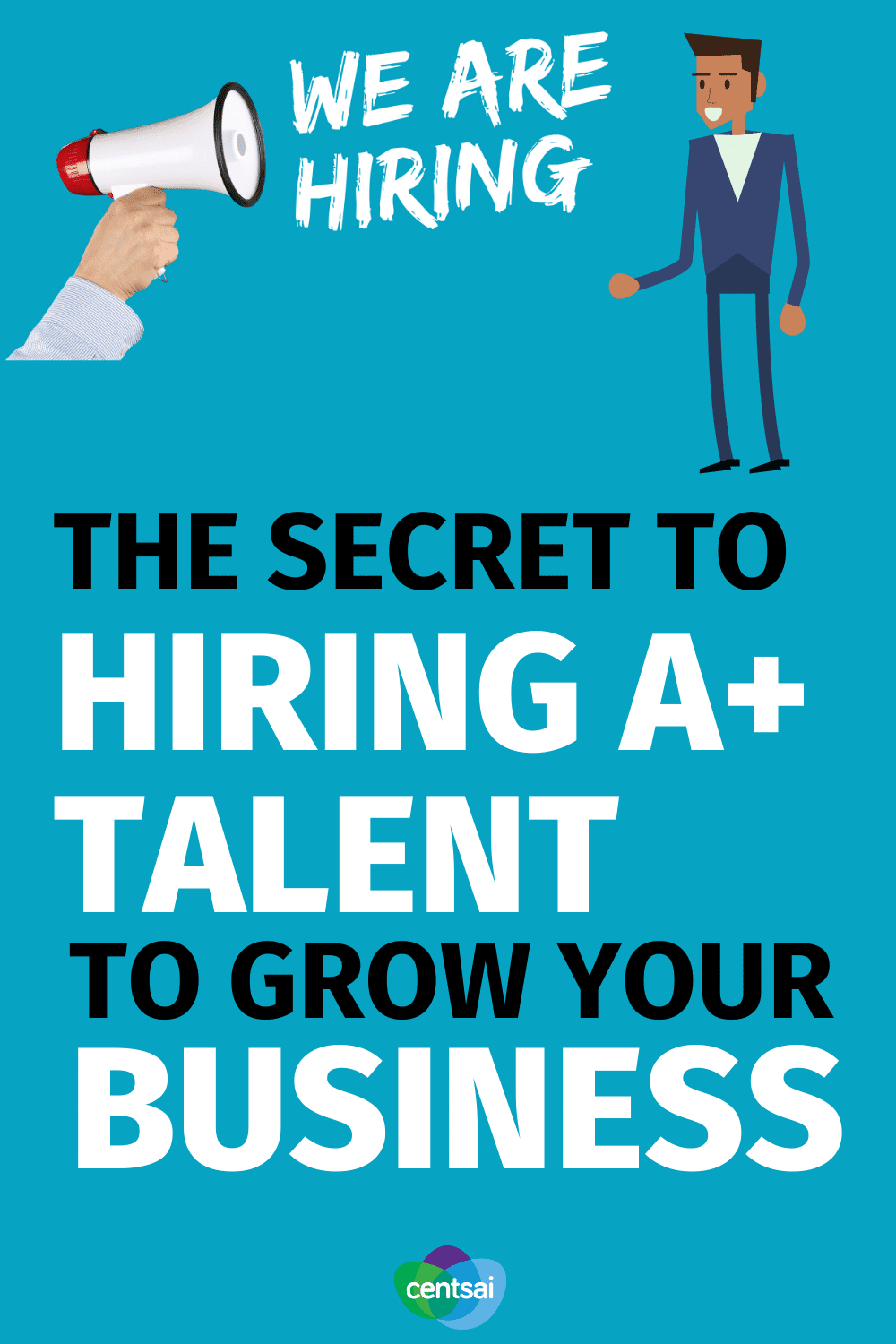

If you’re a small business owner in the midst of scaling your business, you feel the weight of stress on your shoulders that coincides with the pursuit of business growth — and may be looking for some hiring tips when taking on a new team member.
You lie awake at night realizing you must delegate operational responsibilities that you’ve always done yourself, so that you’re not the bottleneck to profits. You also know that you need to hire A+ talent to get the results you expect.
My previous company was delivering almost 4,000 lunches a day when I posted the job description for an operations manager. It was the first management position I filled from outside the company since hiring an executive chef five years earlier. I was nervous and eager at the same time to find a capable, hardworking leader to add to the management team and help us grow.
The anxious feeling of potentially hiring the wrong person was noticeable. I feared wasting time, wasting money, getting even less sleep, and ending up back where I started.
If you’re at the point of growth where you need to hire a key position, you may be experiencing some of the feelings I had.
To set yourself up for success and find the perfect candidate to help you achieve calm and organization within the chaos of your business’ growth, follow these tips to channel your edgy energy into composing an experience-based job description (JD) that will attract the A+ talent you’re looking to hire.

The nine steps below will take you through a step-by-step process to successfully hiring a competent, hardworking team member who fits your company’s culture by crafting a thoughtful, experience-based job description.
This article will provide any owner with the right tips to identify exactly what you’re looking for in a candidate and have a much better chance of hiring the right person.
1. Write a Job Description for Yourself First
To figure out what this new hire’s position will entail, you must decide what your own position will be focused on and what you’ll delegate.
Put yourself in the most creative space you can, and allow your imagination to explore all the areas where you want to spend your time to make your company better.
Anything that comes up for you that you don’t want to do, put that on a list as well.
Review what you write a few times on different days to allow it to soak in and percolate in your mind. Don’t delegate things just because you don’t want to do them. Evaluate what’s in your job description to ensure you’ve created a position for yourself that includes high value responsibilities that make sense for you to keep.
Start Your Free Trial with P2P Today
2. Describe the New Role with Résumé Building Language
This may make me strange, but when I’m writing a job description, I enjoy reading the JDs of roles at companies who I admire, large and small, and who I trust have forward-thinking Human Resources departments — companies like Uncommon Goods and Microsoft.
Reading a well-written JD that makes me want to apply even though I’m not looking for a job helps me tap into what’s exciting about the opportunity I’m creating for the lucky candidate who is ultimately selected for the position I’m creating.
The role description can be one to three short paragraphs and will express the ways the perfect candidate will meaningfully contribute to the company as well as grow their own experience.
The director of operations JD at Uncommon Goods is a great example:
A dynamic leader with e-commerce and business-to-consumer fulfillment experience. Excels at motivating operations managers and supervisors while reporting to the Chief Operations Officer. You hold a high bar for your team. You hold your own performance standards to the same expected level of everyone that you manage. Your values are aligned with our business, people, and customer service culture. You embrace a lean, collaborative team environment, and have an open, direct, and encouraging communication style.
In a single paragraph, Uncommon Goods has expressed the professional growth opportunities and meaningful work this position offers someone. They use words like dynamic, motivating, and values, and they indicate the position reports to the COO, which many folks seek out.
Step 3: Craft a Company Description that Attracts Top Talent
The company description is your opportunity to sell your organization as a place to grow a career and join a team that’s doing remarkable things. Top candidates are doing their due diligence on you the same way you’re going to interview them and check their references.
State your company’s mission and vision and speak to the heart, and don’t be shy about claiming all the great things your company is about.
Start Your Free Trial with P2P Today
This should be no more than one paragraph, three to four sentences. Uncommon Goods accomplished this in two sentences with links to learn more on the company’s website:
Uncommon Goods offers remarkable designs by independent makers, and we do it with a positive impact on people and our planet. Learn more about our products, B Corp certification, Better to Give program, and amazing team members you might be working with.

4. Write the Job Responsibilities in Terms of Actions
This is a meaty section of the JD with six to 10 bullet points. You’ll communicate the specific expectations of deliverables, performance, and examples of activities the hiree will carry out. The responsibilities section intensifies the enthusiasm for qualified candidates looking for the specific opportunity you’re offering while also weeding out job seekers who aren’t ready for the position.
Each sentence you write should start with a verb such as develop, design, build, facilitate, lead, maintain, and monitor.
This is where you’ll include the heart of what you’re delegating to free yourself up to focus on the growth of the business.
Here are a few examples from Uncommon Goods’ director of operations posting:
- Oversee inbound and outbound logistics, from vendor handoff to receiving, monitoring, and improving speed to market
- Manage 3PL relationships ensuring SLAs are met on a weekly basis to meet monthly, quarterly, and yearly forecasting goals, while also supporting in streamlining their operations from a fulfillment and technology standpoint
- Build and implement scalable processes and systems to support operational growth across inventory management, warehouse management, procurement, including assessing systems, new vendor onboarding, developing guides, and leading implementation
- Make recommendations to improve productivity, quality, and efficiency of e-commerce operations, planning, allocation, and product development
The use of industry acronyms will be obvious to qualified candidates and may scare off those not trained in this vernacular. The ability to make recommendations and build new systems will excite a specific type of candidate looking for great responsibility who looks forward to being held accountable.
You may even have a long and short version of this section. The short version is for posting; the long version is the draft of your interview questions once you move to that stage of the hiring process.
5. Focus Job Qualifications.
Keep the job qualifications section of the JD focused on the specific needs you have. For most small businesses, their systems and processes are specific to their way of doing things and you need someone to come in, learn what you’re doing, figure out how to make it better, implement it, and own it.
The skills you’re seeking are as much soft skills — project management, listening, communication, analytical, etc. — as they are about technical skills related to your industry.
When you indicate the number of years of required experience, be thoughtful that you don’t overshoot. Whitney Johnson talks about this in her book Build an A-Team: Play to Their Strengths and Lead Them Up the Learning Curve.
Johnson explains that every employee has an S-curve. At the bottom of the curve, employees are figuring things out and they aren’t as efficient, but after about six months, they begin to apply their new knowledge and make faster progress until they reach their peak productivity.
They enjoy this position a few years until they eventually get bored and then you work together to determine how their growth path coincides with the company’s growth and let them co-create their next job description with you.
Start Your Free Trial with P2P Today
Taking Johnson’s philosophy into consideration, think carefully about where your company is right now in its own life cycle and match this with the needs of the role to choose the amount of prior experience you require for the perfect candidate.
In the case of Uncommon Goods’ JD, here are a few lines from what they require for their director of operations:
- 7+ years of professional experience with evidence of increasing responsibility in operations management
- Experience scaling up and scaling down a seasonal business, including but not limited to hiring 300+ seasonal warehouse associates
- Prior experience managing labor spend, 3PL and overhead costs.
- Bachelor’s degree, or equivalent work experience, preferably with a focus in an analytical field
- Prior small company or start-up experience is a plus; consulting experience is a plus
- Strategic and tactical experience improving, building and executing scalable processes
- Exceptional quantitative skills and aptitude; deep knowledge of Excel and familiarity with databases and SQL
- Strong communication skills and attention to detail
- Creative problem-solver with excitement to work on cross-functional teams and projects
Notice the specificity they indicate beyond the number of years of experience. Uncommon Goods writes, “with evidence of increasing responsibility in operations management.”
When you take the time to think critically about what you need in the position, these are the details you add and what you’ll focus on in the interview.
This is critical to recognizing the right candidate when they’re in front of you.
6. Indicate Travel Requirements or WFH Allowances
Especially in today’s COVID-19 environment, if there is any travel required for this position and if this role can be mostly, if not 100 percent, virtual, you’ll want to mention that as well. One short phrase or sentence is sufficient.
Plus Get Extra Savings When Joining From CentSai
7. Provide Generous Benefits
The saying “you get what you pay for” doesn’t ring truer than when you’re hiring A+ talent . If you’re company isn’t in a financial position to pay at the top end of market rates (or even higher if you’re competing with Google and Amazon), then your opportunity to win A+ talent comes in the form of creative benefits.
What is important to this candidate? What do they need in order to feel like their hard work will reward them as well as the company?
Do they have young children and want to spend time with them in the afternoons after school? Are they young professionals looking to soak up every bit of education they can get their hands on?
Find out what inspires your perfect candidate to show up and do their best work for your company and create a win-win situation by offering something that will add value to their life. Examples of such perks could be a flexible work schedule or being provided with a business coach or access to online courses taught by industry leaders.
Whatever it is, get creative and make them want to say “yes” as much as you want them to say yes.
8. Choose an Appropriate Job Title
Even though the job title goes at the top of the JD, you can write this last. After all the thought you’ve put into knowing the perfect candidate before you meet them in person, the title will come to you more easily if you do this step last.
There is nothing wrong with choosing tried-and-true titles that have worked for decades such as director of operations. If you decide on a more hip and cool title, like data czar, be mindful that some terms may turn off a certain segment of candidates and you don’t want to do that on purpose.
9. Test the Job Description Before Posting
Once you’ve written what you consider to be the perfect JD, test it out by asking others to read it and give you feedback on the language you’ve chosen.
Make sure your testers are diverse: of different backgrounds, ethnicities, ages, genders, sexual orientation, experience levels — you don’t want to accidentally discourage certain segments of candidates from applying.
Make adjustments based on the feedback and post a JD that you feel confident will invite qualified candidates with the right attitude to apply.
In case you’re wondering what happened with my first management hire, about six to eight months after the director of operations joined the team, I began to realize what I needed her responsibilities to be. It took me more time than I like to admit to figure this out, but as I figured it out, I wrote it down.
After another six months, I rewrote the job description using these steps.
Every job description I write now is considered the first step in orientation and onboarding of the new employee and is referenced on a regular basis, updated as necessary, and used as a tool to keep me and my employee on a win-win path.
Belinda DiGiambattista is a serial entrepreneur, business coach, and outsourced financial controller and can be found at www.belindadi.com.
Start Your Free Trial with P2P Today





